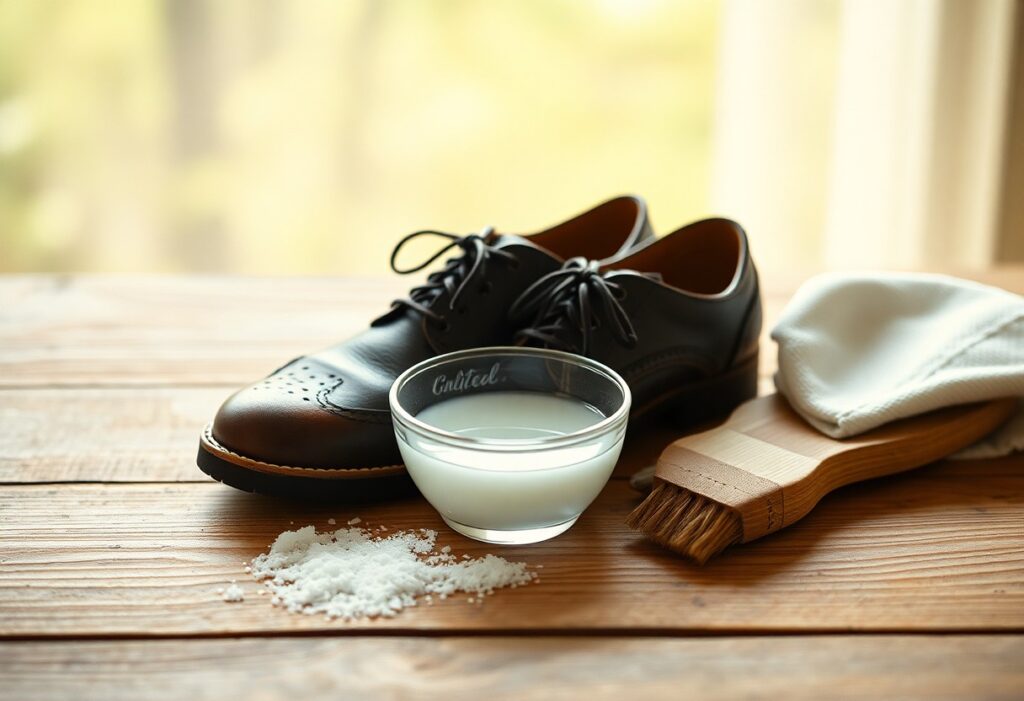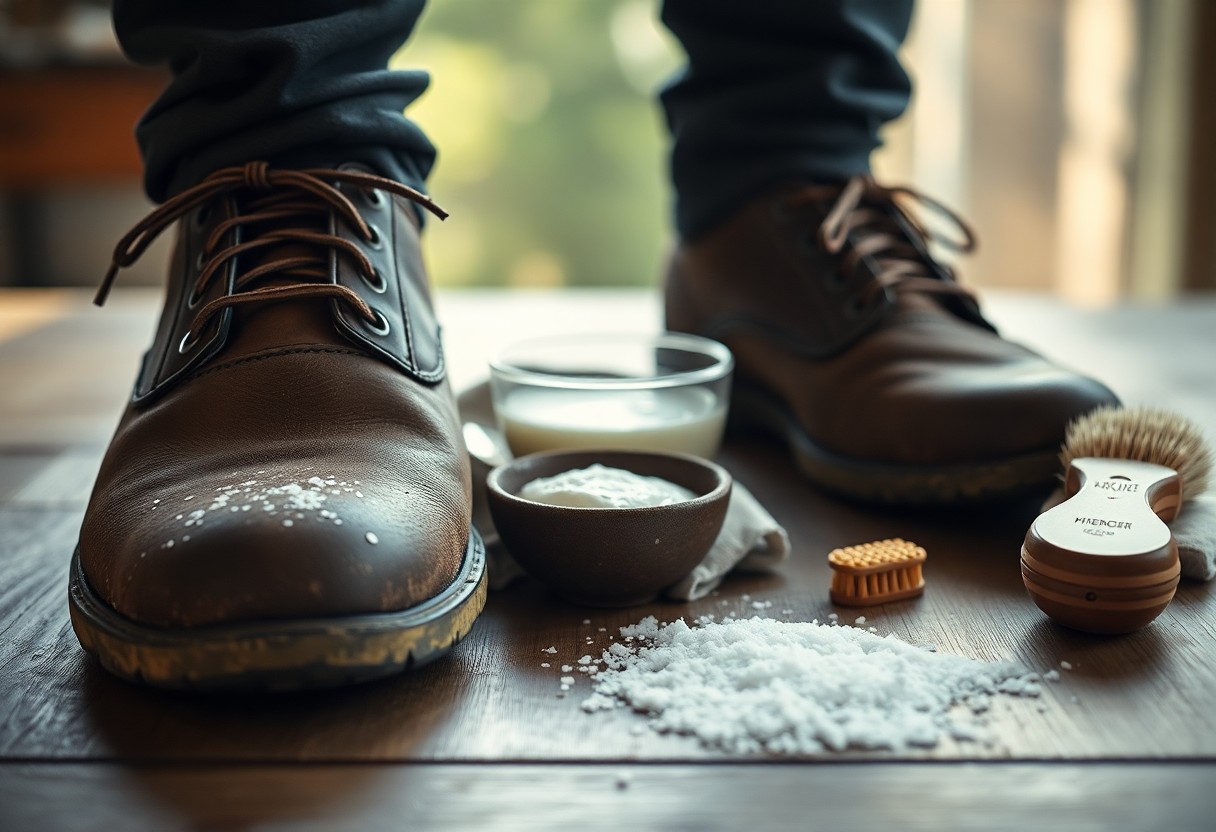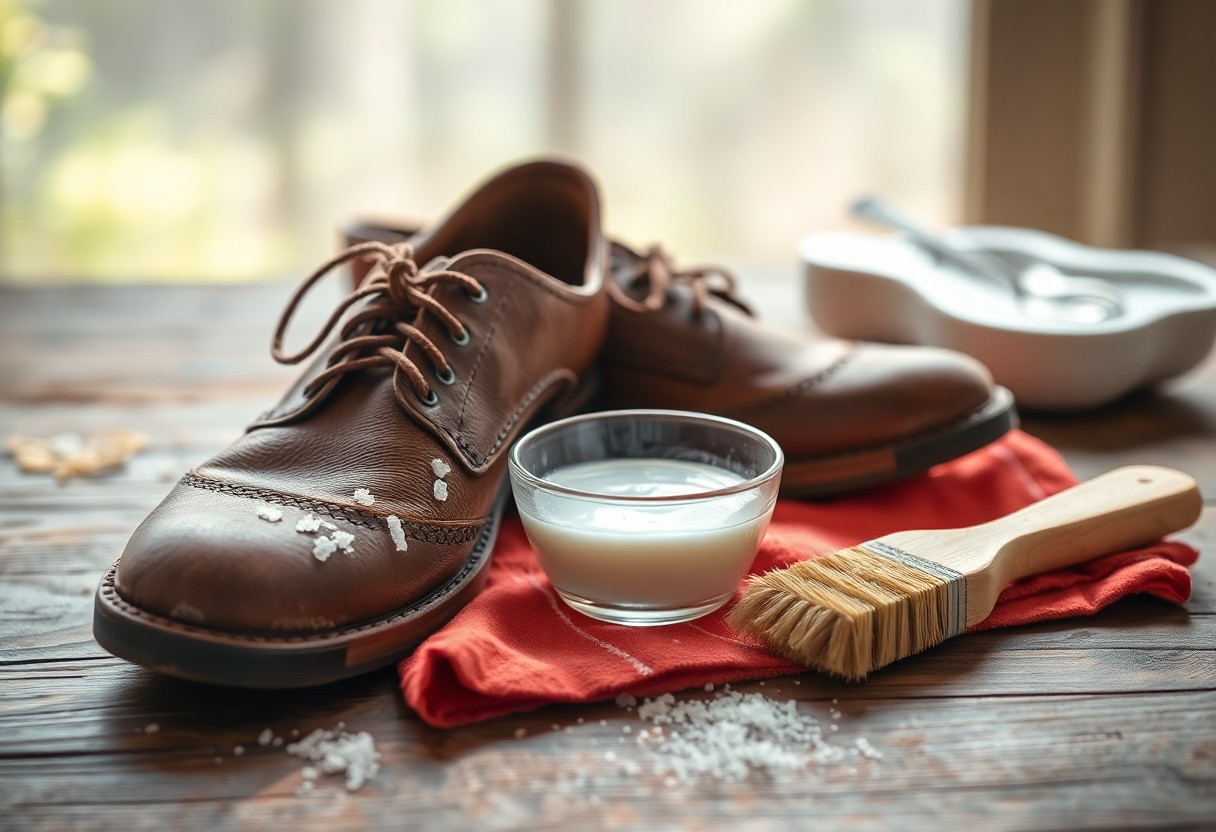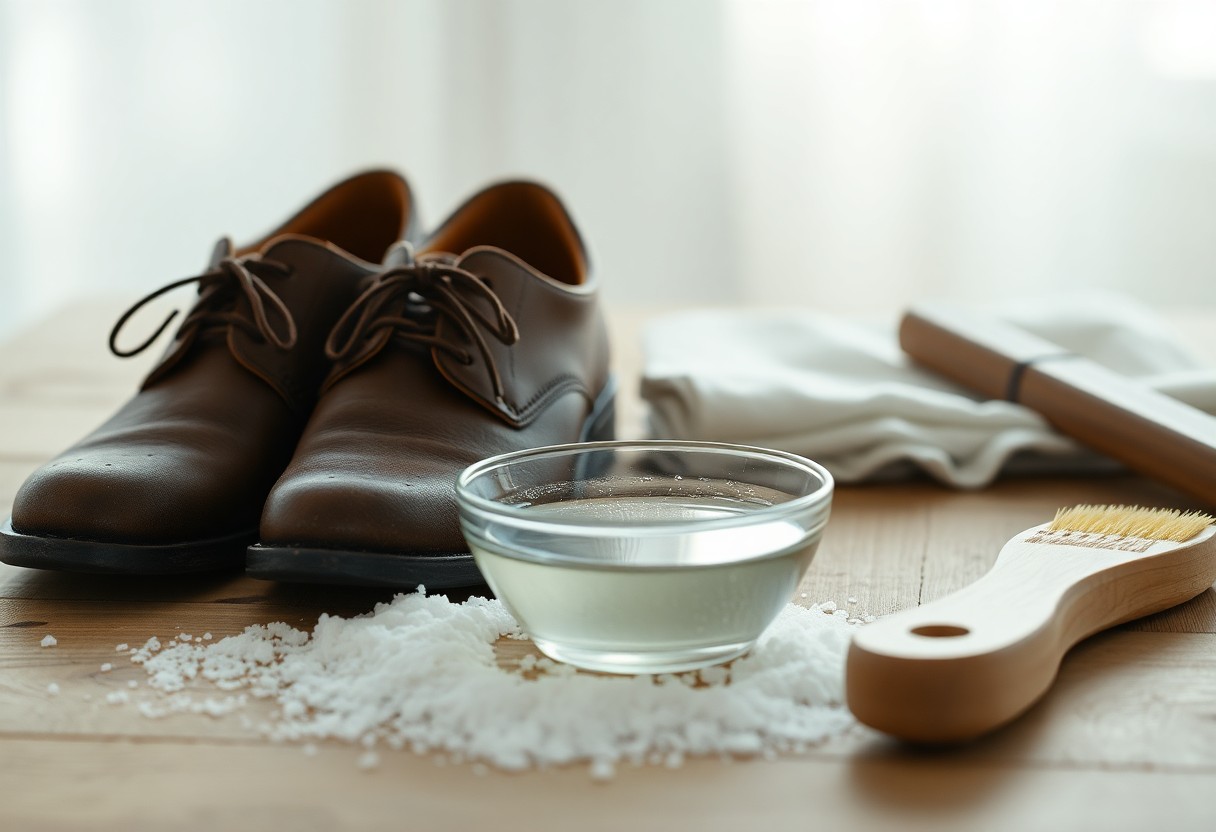
Implementing effective strategies to protect your shoes during winter is essential for avoiding the damaging effects of road salt. In areas facing severe cold, your footwear experiences continuous exposure to harmful road salt, which can significantly compromise the integrity of leather and leave behind unsightly stains. The key to maintaining your shoes lies in taking proactive measures, beginning with regular cleaning and appropriate care techniques. This comprehensive guide will provide you with practical methods to prevent and effectively remove salt stains, ensuring that you extend the lifespan of your shoes and maintain their pristine appearance. Discover time-tested techniques for daily maintenance and stain removal that will protect your footwear throughout the harsh winter months.
Understanding the Harmful Effects of Salt Stains on Your Footwear
Recognizing the impact of winter weather combined with road salt is critical for safeguarding your footwear. When shoes come into contact with salt-laden snow and slush, they end up with white residue and permanent stains that can severely diminish both the aesthetic appeal and structural integrity of your footwear. Salt not only tarnishes the appearance of your shoes but can also lead to more serious long-term issues, such as cracking and weakening of the materials, especially when left unaddressed. Early detection of salt damage is vital, as it allows for corrective action before it escalates into more significant problems that could necessitate costly repairs or replacements.
Recognizing Different Types of Salt Stains on Various Footwear Materials
- Leather shoes show noticeable white rings and patches
- Suede material tends to develop crusty white deposits
- Canvas shoes may exhibit a powdery white residue
- Synthetic materials might present discolored spots
| Material | Characteristics of Salt Stains |
|---|---|
| Leather | Visible white rings and dried patches |
| Suede | Crusty white deposits |
| Canvas | Powdery white residue |
| Synthetic | Discolored spots |
| Nubuck | Rough white patches |
How Salt Exposure Compromises Leather and Other Shoe Materials
The immediate consequence of salt exposure is the dehydration of leather fibers. Salt functions as a desiccant, drawing essential moisture from your shoes, which can lead to cracking, discoloration, and overall structural weakening of the material over time. The presence of salt can disrupt the natural oils that keep leather supple and resilient, leading to a significantly decreased lifespan for your beloved footwear.
If left untreated, road salt stains can inflict permanent damage, making it vital to act swiftly. The corrosive nature of salt breaks down the natural oils found in leather, compromises fiber bonds, and can eventually lead to irreversible degradation of your shoes. To protect your investment, it’s crucial to tackle any salt stains within 24 hours to prevent lasting damage that could ruin your footwear for good.
Proactive Strategies to Prevent Salt Damage on Shoes During Winter
To effectively shield your shoes from salt damage, it is essential to engage in proactive care strategies. Start by applying a waterproofing treatment to your shoes before the winter season kicks off, and ensure regular application of protective sprays throughout the winter months. These preventive measures create a barrier against salt-laden water, helping to keep your shoes safe from direct contact with corrosive elements that could harm the leather surface.
Pre-treatment Solutions and Protective Measures for Footwear Defense
Maximize your shoes’ defense against salt damage by applying a high-quality leather conditioner followed by a reliable waterproofing spray. It’s advisable to reapply these protective layers every 2-3 weeks during the winter months to ensure ongoing protection. For enhanced durability, consider using a wax-based protector as an additional layer of defense against the harsh winter elements that threaten your footwear.
Best Practices for Winter Shoe Maintenance
Implementing effective winter shoe care techniques is vital for maintaining the integrity of your footwear. Prioritize daily cleaning and proper storage practices to protect your shoes from salt damage effectively.
- Clean your shoes immediately after exposure to salt
- Utilize shoe trees when storing to maintain shape
- Rotate between multiple pairs of shoes to reduce wear
- Consistently apply protective spray to maintain defenses
Every winter day presents a risk to your shoes, making vigilance crucial.
Winter maintenance requires your consistent attention and commitment to detail.
- Regularly check weather forecasts for salt warning days
- Keep cleaning supplies readily available at home and work
- Schedule regular protective treatment days into your routine
- Monitor the condition of your shoes on a weekly basis
Remember, prevention is always better than dealing with damage after it occurs.

Step-by-Step Guide to Effectively Remove Salt Stains from Shoes
Effectively removing salt stains from your shoes can be accomplished by following a systematic approach. This detailed process requires careful attention to detail and the right cleaning supplies to ensure successful stain removal without damaging the leather.
| Basic Cleaning Items | Advanced Cleaning Items |
| Warm water, Clean cloth, Paper towels | Vinegar, Lemon juice, Leather cleaner |
Basic Techniques for Treating Fresh Salt Stains
Salt stains are most easily managed when treated immediately. Use a clean, damp cloth to gently wipe your shoes from top to bottom, ensuring that you frequently change the cloth section to prevent spreading the salt further onto the leather. This immediate action can often prevent the stains from setting, making future cleaning much easier and more effective.
Advanced Techniques for Stubborn Salt Stains Removal
- Combine equal parts water, vinegar, and lemon juice in a bowl
- Gently apply the solution using a soft cloth
- Wipe in one direction only to avoid damaging the leather
- Exercise caution to avoid oversaturating the leather during the cleaning process
Successfully cleaning stubborn salt stains necessitates a methodical approach. Always remember to test cleaning solutions on a small, hidden area first to confirm they won’t harm your shoes, thereby avoiding any potential damage.
| Immediate Care Steps | Long-term Protection Steps |
| Air dry your shoes at room temperature | Apply leather conditioner consistently |
Essential Tools and Recommended Products for Optimal Shoe Care
To effectively treat salt stains, you need to have a well-organized cleaning kit available at your disposal. Your basic kit should include clean white cloths, a soft brush, paper towels, and a bowl for mixing cleaning solutions. Always keep a designated cloth for cleaning at both home and work to ensure a swift response to any salt exposure that may occur.
Recommended Cleaning Solutions and Materials for Optimal Shoe Care
The most effective cleaning solutions consist of a mix of equal parts water, vinegar, and lemon juice. Additionally, consider using commercial products like Saphir salt stain remover for enhanced efficacy. Your cleaning kit should also incorporate leather conditioner, shoe cream, and waterproofing spray for post-cleaning care. Avoid harsh chemicals that could potentially damage your shoes during the cleaning process, as they can compromise the integrity of the materials used.
Comparing Professional vs. DIY Cleaning Products for Shoe Maintenance
With a variety of both store-bought and homemade solutions available, you have multiple options for your shoe care routine. Professional products often come with specialized formulations designed for efficiency and ease of use, while DIY solutions utilizing household items can be equally effective and more cost-efficient. The choice between these options ultimately depends on the value of your shoes and the frequency of cleaning required.
Cleaning products differ significantly in their application methods and effectiveness. Professional cleaners typically offer faster results but come at a higher cost. DIY remedies such as the water-vinegar-lemon mixture may demand more time and effort but allow you greater control over the ingredients used. The quality and type of your leather shoes should guide your decision on which product to select for optimal care.

Environmental Conditions Impacting Shoe Care During Winter
While regional variations exist, salt exposure and leather damage are influenced by numerous environmental factors. The challenges faced by your shoes can differ based on location, climate, and the urban infrastructure surrounding you. Temperature fluctuations, humidity levels, and the type of salt used on roads can all play a significant role in determining the severity of staining and damage. Recognizing these factors empowers you to adapt your protection strategies accordingly to ensure your footwear remains in good condition.
The Influence of Weather Conditions on Footwear and Salt Damage
The impact of weather conditions on your shoes’ susceptibility to salt damage can vary greatly. When temperatures hover around freezing, wet conditions heighten the risk of salt infiltrating the leather. You are likely to notice more severe staining during freeze-thaw cycles, where temperatures fluctuate drastically between day and night. Your shoes face heightened vulnerability during early spring when melting snow mixes with residual road salt, necessitating extra care during this transitional period to protect them from damage.
Proper Storage and Maintenance of Shoes During Winter Months
In the winter season, ensuring your shoes are stored correctly becomes paramount for their protection. You should keep your footwear in a dry environment with stable temperatures, away from direct sources of heat. Regular cleaning after each use is vital to prevent salt buildup, while proper ventilation is necessary to avoid moisture accumulation that could lead to further damage over time.
Consistent attention to detail during winter shoe care is essential. Never store damp shoes in closed spaces, as this can trap moisture and accelerate salt damage, leading to more serious issues down the line. It is advisable to maintain a regular cleaning schedule and utilize shoe trees to preserve shape and absorb excess moisture. Applying protective treatments before winter begins will create an effective barrier against salt exposure and help keep your shoes looking great.
Comparative Analysis of Treatment Methods for Salt Stain Removal
To keep your shoes protected, it’s important to select the right treatment method. Below is a comparison of available options to assist you in making an informed decision:
| Commercial Solutions | Home Remedies |
|---|---|
| Fast-acting formulas | Cost-effective alternatives |
| Specialized protection | Made from natural ingredients |
Pros and Cons of Chemical-based Solutions for Shoe Care
Utilizing chemical-based solutions offers quick results but requires careful handling and consideration of safety protocols. Here are some factors to weigh:
| Pros | Cons |
|---|---|
| Rapid effectiveness | Higher overall cost |
| Long-lasting protective benefits | Potential use of harsh chemicals |
| Professional-grade results | Possible environmental impact |
| Consistent performance | Specific storage requirements |
Natural Remedies: Advantages and Limitations for Effective Shoe Care
While natural remedies may take longer to deliver results, they provide safer alternatives for both your shoes and the environment. Utilizing eco-friendly solutions can benefit your footwear while also being kinder to the planet.
Natural solutions, such as vinegar and lemon juice mixtures, offer gentle cleaning action without the risk of harmful chemicals. Although these methods may require more frequent application, they are budget-friendly and easily accessible in most households, making them a practical choice for many shoe owners seeking to maintain their footwear without incurring significant costs.

Establishing a Long-term Care Routine for Your Shoes
To ensure your shoes remain protected against salt damage throughout the year, it is essential to adopt a comprehensive care routine. This routine should include regular waterproofing treatments, deep cleaning at the change of seasons, and appropriate storage during off-seasons. After winter ends, thorough inspection and restoration of your footwear are crucial for maintaining both durability and appearance, allowing you to enjoy your shoes for many seasons to come.
Maintenance Strategies for Long-lasting Shoe Care Post-treatment
Even after successfully removing salt stains, your shoes require ongoing care to prevent future damage. Key maintenance steps include:
- Weekly conditioning of leather surfaces to keep them supple and resilient
- Application of protective sprays every month to maintain a barrier against moisture and stains
- Storage of shoes with cedar shoe trees to preserve shape and absorb excess moisture
- Use of protective covers during wet conditions to shield against exposure to salt and moisture
After treating salt stains, always allow your shoes to air dry naturally for at least 24 hours to ensure they retain their shape and integrity.
Creating a Regular Care Routine and Schedule for Footwear Maintenance
Maintaining your shoes should adhere to a structured schedule for optimal care. Clean your shoes after each wear during the winter months, apply protective spray every 4-6 weeks, and perform deep conditioning treatments monthly to keep them in peak condition.
It’s essential to recognize that prevention is better than cure when it comes to salt damage. Your regular care routine should encompass daily wiping, weekly cleaning, and monthly protection treatments. This systematic approach not only extends the lifespan of your footwear but also ensures they maintain their appearance through the challenges posed by winter conditions.
Key Takeaways for Protecting and Maintaining Your Footwear
With these insights, your best strategy against salt damage combines proactive prevention with prompt action. To protect your shoes, make it a habit to wipe them down immediately after exposure to salt, utilizing proper techniques and suitable cleaning solutions. If you notice salt stains, act quickly with a vinegar-water-lemon solution or specialized cleaners. Always follow up with conditioning your leather to restore lost moisture. By implementing these straightforward steps, you’ll be able to keep your shoes looking great and extend their life throughout the winter seasons.
Common Questions and Answers About Shoe Care
Q: What actions can I take to prevent salt stains on my leather shoes during winter?
A: To prevent salt stains, promptly clean your shoes after salt exposure using a damp cloth with warm water. Wipe from top to bottom in one direction, changing the cloth section frequently to minimize the spread of salt. Additionally, applying a leather protector before the winter season begins can create an effective barrier against salt damage.
Q: What is the most effective homemade solution for removing existing salt stains from leather shoes?
A: Create a mixture using equal parts water, vinegar, and lemon juice for an effective salt-dissolving solution. Use this mixture with a clean cloth, wiping from top to bottom, and clean the cloth often during the process. After removing the salt, wipe the shoes with plain water using a fresh cloth, then allow them to dry completely before applying leather conditioner to restore moisture.
Q: How can I determine if I have successfully eliminated all salt from my shoes?
A: Check for any remaining white residue on the leather surface; if none is visible, you have likely removed all the salt. Be aware that dark stains may linger even after salt removal. These marks indicate areas where the salt has compromised the leather, but they do not signify active salt presence. Always condition the leather after cleaning to replenish moisture and maintain its quality.
The Article Guide to preventing and removing salt stains from shoes effective tips and techniques appeared first on My Shoes Finder
The Article Preventing and Removing Salt Stains from Shoes: Effective Tips Was Found On https://limitsofstrategy.com
Comments
One response to “Effective Tips for Preventing and Removing Salt Stains from Shoes”
Your insights into the importance of protecting footwear during winter resonate deeply with anyone who has experienced the toll that harsh weather can take on shoes. The problem you describe is not just about aesthetics; as someone who lives in an area where road salt is a regular winter companion, I’ve witnessed firsthand how quickly shoes can deteriorate if not properly cared for. Leather, in particular, requires special attention—something many people may not fully appreciate until it’s too late.